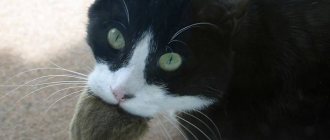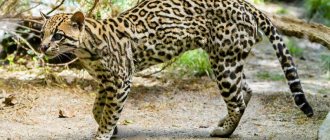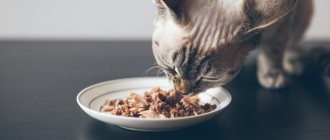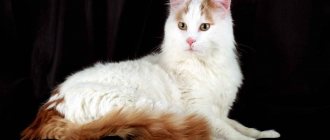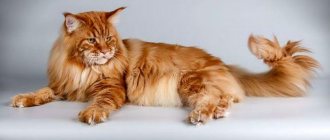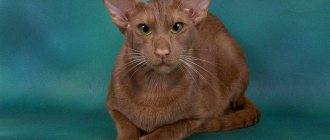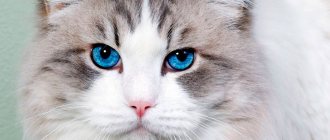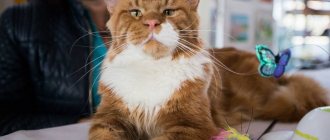Hello, dear readers!
I am glad to welcome you to the pages of the “Cat City” blog.
Do you love to travel?
I - yes! Imagine, every new trip and acquaintances on a long journey replenish my collection of interesting discoveries. Then I willingly talk on the pages of this blog about pleasant meetings and adventures.
My new story is about hybrid, unique cats.
Their first descendants appeared in the United States in 1960. Felinologists still continue to conduct breeding work on crossing the wild reed cat with the domestic Abyssinian cat. Modern hybrids get their name from the Latin Felis Chaus.
Evgeniy, the breeder (@ chauzi.zara) of this exotic, one of the most expensive, cat breed, told me in detail about the chauzi, a description of the breed and character.
Buy a Chausie kitten
We deliver Chausie kittens anywhere in the world!
Have you decided to buy a Chausie kitten? You have made the right choice - the Chausie kittens presented in this section of the site are ready to go. Check out the Chausie kittens below - they are gorgeous! It doesn’t matter where you live - kittens of the cattery of rare breeds of cats are not afraid of distances and are ready to travel anywhere on our planet.
The kittens' parents were tested for leukemia, immunodeficiency and coronavirus with negative results. Before purchasing a Chausie kitten, please read the purchase agreement
Description and breed standard
These cats definitely cannot be confused with other animals. Housei are large and muscular, the average weight of representatives of this family is 10-15 kg. They grow up to the age of three.
Males are noticeably larger than cats. The Chausie breed has its own calling card - representatives of the F1 generation have tufts on their ears. This external feature was inherited by the animals from their wild ancestors. Tassels can be exclusively black.
Description of the Chausie breed:
- small muzzle with an elongated nose and pronounced cheekbones;
- erect large ears;
- muscular paws, which Housie cats also received from their wild ancestors;
- eyes slightly slanted, ideally amber or green-yellow;
- large neat body, powerful short neck;
- strong legs, with the hind legs longer and stronger;
- the tail is small, given the size of the animal, but not less than 3/4 of the body length.
The jungle cat is most similar in appearance to Chausie cats. The Shawsie or Hausie is only slightly inferior to its wild counterparts in weight and height.
It is also worth considering that the patterns on the body of Chausie cats can be blurry and resemble water ripples. The designs on the paws, tail and head must be clear. Often, in their bizarre shape, the pictures on wool resemble necklaces.
Coat and colors
Chausie cats have short and elastic hair. In healthy animals it should be very thick and shiny. The coat of these cats is inherited from the swamp lynxes living in the wild, so it provides protection against harsh weather conditions.
Coloring can include up to 5 different shades. But according to the standard, no more than 3 are allowed:
- black color;
- ticked tabby (grizzly color);
- silver ticked color.
Representatives of litters from F1 to F3 can boast of these colors. If an animal has predominant domestic cat genes, its coat may be a different shade. But such pets are not allowed to show and are not considered purebred representatives of the breed.
The tip of the tail and ear tufts should be black. This distinctive feature of Chausie F1.
Another distinctive feature of Hausie cats is the “necklace” on their neck. Preferred representatives of the breed have small dark spots on their ears. Dark patterns may also be present on the head and tail. Each hair of the animal is colored in two shades at once, but this cannot be seen with the naked eye.
Story
The first representatives of the “Chausie” appeared relatively recently - in the 70s of the 20th century (US felinologists received the first representatives of these cats as a result of crossing Abyssinians and jungle cats).
Chausie looked like their wild ancestors, while possessing the habits and dispositions of domestic pets - breeders liked these features, and the Chausie breed began to gain popularity.
This breed was officially registered quite recently (in 1995, TICA), but has already gained loyal fans around the world.
Maintenance and care
Chausie is an active cat that requires a lot of attention. In terms of their temperament, these animals are not far removed from their wild ancestors. They love to run, jump and play for a long time.
It is unlikely that representatives of the breed will be happy living in a small house in the city center. It is better to have them for people who live in large apartments or in a private house and have the opportunity to relax in nature.
A cat can cause a lot of trouble if it doesn't have toys. The pet will begin to play with curtains, dishes, various hygiene items and everything that seems suitable to him.
The animal should have a separate corner, equipped with special devices - walls, soft and rubber toys, multi-level houses and a scratching post.
Houseies love water, a quality they inherited from swamp lynxes. But experienced veterinarians do not recommend bathing cats too often. Due to the nature of wool (it practically does not get dirty), 2-3 water procedures per year and several if necessary are enough.
Chausie cats must be brushed with a soft brush 1-2 times a week. You also need to periodically clean your ears and trim your nails. Otherwise, keeping these cats at home does not bring any trouble.
Nutrition
Choosing a diet for a cat is extremely difficult. Chausie cannot eat commercial dry and wet food, regardless of its cost and quality. Also, the animal’s digestive system does not digest cereals and grains.
Character traits
The personality of these miniature cougars is the exact opposite of their appearance. These, at first glance, wild and predatory animals are very friendly, not at all aggressive. Cats quickly get used to their new home, and from the very first minutes of their stay in the apartment they will try to get to know all the household members and other pets better.
The Chausie cat is able to make friends even with large dogs, and will perceive them as companions in games and pranks.
Chausie kittens are extremely playful and inquisitive creatures that will soon turn the entire house into a large play area. They are interested in literally every thing and every corner in the apartment, and they will not miss the opportunity to explore all the rooms available to them.
Most Chausie owners claim that their pets are observant and insatiably curious, so these cats rarely pay attention to prohibitions, and will definitely find a way to get into places where they are strictly prohibited from entering.
Nature has endowed these active and agile cats with incredible jumping ability, thanks to which they can easily jump onto the highest shelves or surfaces of cabinets and mezzanines. For these exotic pets, it is recommended to purchase a special play complex with many shelves located on different levels, where these cats will spend all their free time.
It is also advisable to purchase various toys for animals, otherwise they will exercise their hunting skills on all household things, such as the TV remote control or the owner’s mobile phone.
Despite the fact that Chausies have long been considered domestic cats, they have retained some wild instincts. A characteristic feature of these animals, inherited from their wild relatives, is their ability to stockpile for a rainy day. The Chausie cat will, unnoticed by its owner, hide food or small items in its hiding places, which are often very difficult to detect. It is almost impossible to wean your pet from this habit.
The Chausie cat becomes extremely attached to its owner and experiences separation from him very hard . Miniature cougars prefer to be near people all the time and require a lot of attention and care. In the absence of their beloved owner for a long time, these cats can become depressed and even get sick, so it is undesirable to leave them alone for a long time.
Feeding
The digestive system of the Chausie is not capable of digesting grains, so the pet's diet should consist largely of meat products. It will not be possible to replace food with dry food.
The pet eats meat only raw and lean. Rabbit, beef, quail are suitable. Pork is contraindicated. The cat also happily eats fish.
As mentioned earlier, representatives of this breed are very gluttonous, so it is better to hide all leftover food.
Be sure to leave a bowl of water.
You need to add vitamins and calcium to your food.
